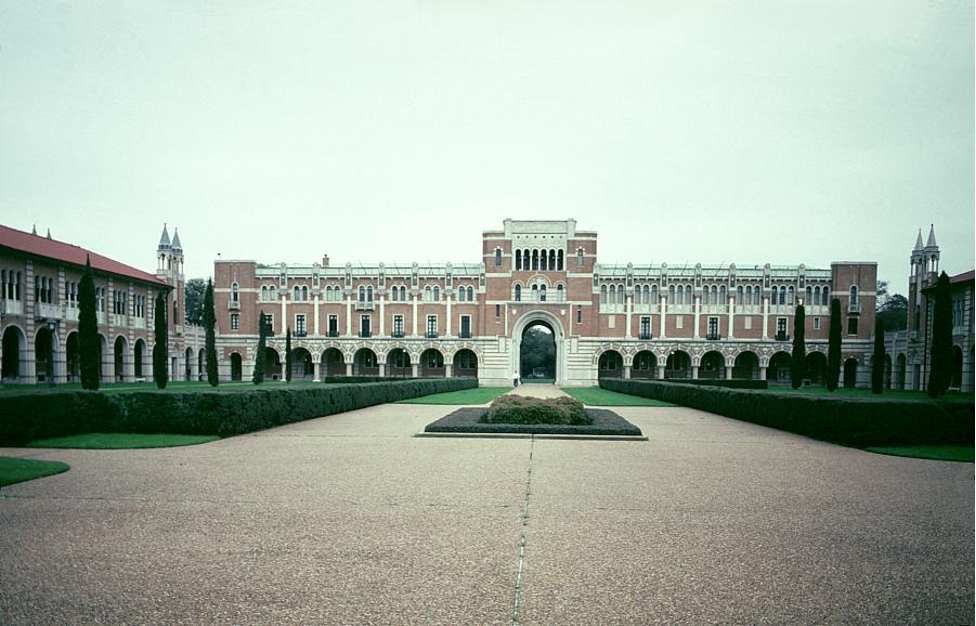Welcome to Rice and Seek, a one-of-a-kind scavenger hunt that will take you on a journey through the hidden symbols, quirky details, and architectural oddities of Rice University!
Rice’s campus is more than just beautiful, it’s packed with secret carvings, mysterious inscriptions, and historical gems that most people walk past every day without noticing. But not you! Your mission? Find them all, snap a photo at each stop, and test your Rice knowledge with fun trivia along the way.
What to Expect:
- A guided path that ensures you won’t be wandering in circles.
- Different iconic and hidden spots across campus, from face carvings to whispering walls.
- Fun trivia questions at each location—will you get them all right?
- A history and answer section at the end to uncover the secrets behind each stop.
How to Play:
- Follow the scavenger hunt path (or not, it’s your call)
- Take a creative photo at each location.
- Try to answer the trivia question before checking the answers at the end.
- Share your photos (don’t forget to tag Rice GPS) and challenge friends to complete the hunt!
Get ready to see Rice’s campus like never before—one hidden detail at a time!
I recommend following the proposed route, which follows a circular path around campus to ensure an efficient walk without backtracking! But feel free to explore campus your way, this is your experience!
Starting Point: Lovett Hall (Main Entrance) → Herzstein Hall → Keck Hall & Anderson Buildings → Will Rice & Baker College → Final Stop: Fondren Library → Throughout the road: Pine-Owl-Ples.
Let’s start.
Scavenger Hunt Stops + Trivia
Face Carvings in Lovett Hall & Sallyport
Lovett Hall Towers & Sallyport
Find and photograph the mysterious faces gazing down from Lovett Hall. Are they watching over students… or judging their exams?
Trivia Question:
Some of these carved faces are said to represent:
- Former Rice Presidents
- The founders of Rice University
- Mythical creatures
- The stages of college life
Lovett Hall Cornerstone
Lovett Hall
Capture the stone that marks the university’s foundation, literally!
Trivia Question:
What year was Rice University officially founded?
- 1912
- 1900
- 1891
- 1911
Bronze Owls in Herzstein Hall
Herzstein Hall (Old Physics Building)
These hidden metal owls keep a watchful eye on campus. Find and document them!
Trivia Question:
Rice University’s official mascot, the owl, comes from which secret society?
- The Illuminati
- The Athenaeum Literary Society
- The Freemasons
- The Order of the Phoenix
Angry Dolphins Door Handles
Herzstein Hall
These quirky, slightly irritated dolphins adorn the entrance, what are they so mad about?
Trivia Question:
What’s the best guess as to why these dolphins look so grumpy?
- They symbolize Rice’s rivalry with Texas A&M
- A reference to failed marine biology studies
- The artist liked mischievous expressions
- It’s a mystery, no one really knows!
Kircher’s Enigma (Keck Hall)
Keck Hall
A puzzle carved in stone. Snap a shot of this cryptic symbol!
Trivia Question:
Athanasius Kircher, whom this enigma references, was famous for his work in what field?
- Cryptography
- Alchemy
- Egyptology
- All the above
Biology Bricks
Anderson Biological Laboratories
The side of the building has fossil-like imprints of plants and organisms. Find the most interesting one!
Trivia Question:
One of these bricks contains an imprint of a famous fossil. What kind of fossil is it?
- Human skull
- Dinosaur bone
- Fern leaf
- Ammonite
Frog Wall
Anderson Hall (Architecture Building)
Run your fingers along the holes and listen to the frog sounds!
Trivia Question:
What scientific principle explains the frog-like sound when you run your fingers over the wall?
- Air friction and vibration
- Piezoelectric resonance
- Soundwave amplification
- Sonic illusion
Terra Cotta Reliefs
Will Rice College
Find and capture these intricate, storytelling sculptures.
Trivia Question:
What story or theme do these reliefs represent?
- Greek mythology
- Commemoration of Will Rice college’s foundation
- Important moments in Will Rice history
- A mix of art, jokes, student life and Rice history
Secret Bible Verses
Baker College
The inscriptions are hidden-how many can you find?
Trivia Question:
What’s the reason for Bible verses being inscribed at Baker College?
- A hidden tribute to Rice’s founders
- It was originally a religious school
- Secret messages for students to decode
- Just a quirky design choice
Development of Writing Plaque
Fondren Library Entrance
Rice honors the evolution of writing. Capture this tribute to human communication!
Trivia Question:
What ancient civilization is credited with the earliest form of writing, which is depicted on this plaque?
- Egyptians
- Sumerians
- Chinese
- Mayans
The Pine-Owl-Ples
Hidden around campus
These unique carvings have an owl-ish twist. Can you spot them all?
Trivia Question:
Why do these owl carvings look like pineapples?
- A tribute to Rice’s unofficial pineapple-loving professor
- A play on architectural motifs
- Mistaken carving interpretation by early students
- No one knows, it’s just an odd design!
Congratulations, you’ve completed the Rice and Seek Scavenger Hunt!
You’ve uncovered hidden faces, whispered secrets, puzzled over cryptic symbols, and met some very grumpy dolphin door handles. Along the way, you’ve explored Rice’s rich history, quirky traditions, and the small details that make this campus truly unique. Whether you aced the trivia or learned something new, you now have an eye for the hidden stories behind Rice’s architecture and symbolism. But don’t stop here, there are always more secrets waiting to be discovered! So next time you walk through campus, look a little closer… who knows what you’ll find?
Trivia answers
- Face Carvings in Lovett Hall & Sallyport – (Answer: d) The columns of the Sallyport are carved to portray the four stages of college life
- Lovett Hall Cornerstone – (Answer: d) 1911. The university was founded in 1911 but opened for classes in 1912.
- Bronze Owls in Herzstein Hall – (Answer: b) The Athenaeum Literary Society. This old Rice literary society used the owl as their symbol, which later became the university’s mascot.
- Angry Dolphins Door Handles – (Answer: d) It’s a mystery! No official explanation exists, making them one of Rice’s oddest architectural quirks.
- Kircher’s Enigma – (Answer: d) All of the above. Kircher was a true Renaissance man; his work touched on cryptography, alchemy, and even Egyptology!
- Biology Bricks – (Answer: c) Fern leaf. One of the bricks has an ancient fern leaf fossil imprint, a nod to biological evolution.
- Frog Wall – (Answer: a) Air friction and vibration. The texture and spacing of the holes cause sound waves to mimic frog croaks!
- Terra Cotta Reliefs – (Answer: d) A mix of art, jokes, student life and Rice history. They show a comical version of student life and Rice’s football success story.
- Secret Bible Verses – (Answer: a) A hidden tribute to Rice’s founders. The engravings were meant as subtle acknowledgments of the original donors.
- Development of Writing Plaque – (Answer: b) Sumerians. The earliest known writing system, cuneiform, came from Sumer around 3100 BCE.
The Pine-Owl-Ples – (Answer: b) A play on architectural motifs. The carvings were likely stylized to resemble both owls and pineapples in an artistic twist!
Behind Every Stop: The Stories of the Hunt
Now that you've completed the scavenger hunt, it's time to uncover the hidden history and fun facts behind each stop! Every carving, inscription, and quirky detail you found has a story. Some tied to Rice’s founding, others wrapped in mystery, and a few that remain unsolved to this day. From secret society connections to architectural oddities, these symbols tell the story of Rice in ways most people never notice. Let’s dive into the fascinating history behind each landmark you visited!
Face Carvings in Lovett Hall & Sallyport
The columns of Sallyport are carved to portray the four stages of college life: It starts with the face of the silly-looking freshmen, and it ends with the head of the wise and handsome graduate wearing his mortar board.
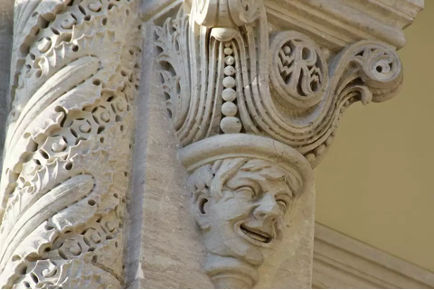

Photo by: jaydrydenphoto.com
Lovett Hall Cornerstone
This cornerstone marks the birth of Rice University. It was laid in 1911, and it’s tradition for students to take graduation photos here. It has inscripted a quote from Eusebius of Caesarea: “’Rather,’ said Democritus, ‘would I discover the cause of one fact than become king of the Persians.’” This reflects the university's dedication to the pursuit of knowledge over material gain.

Photo by: jaydrydenphoto.com
Bronze Owls (Herzstein Hall)
Herzstein Hall, originally the Physics Building, houses bronze owl sculptures. The owl, symbolizing wisdom, is also Rice's mascot, inspired by the Athenaeum Literary Society, an early student organization.
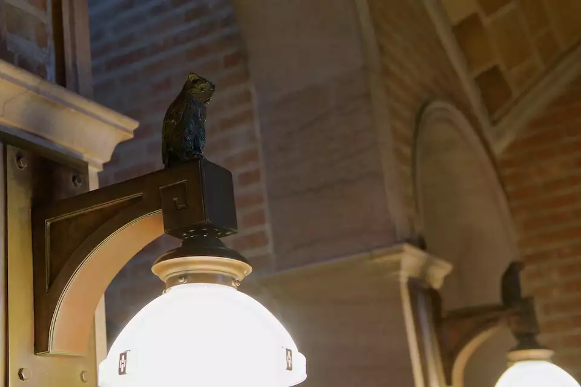
Photo by: jaydrydenphoto.com
Angry Dolphins Door Handles
The entrance to Herzstein Hall features door handles shaped like dolphins with notably angry expressions. The reason behind their grumpy appearance remains a campus mystery, adding to the building's quirky charm.
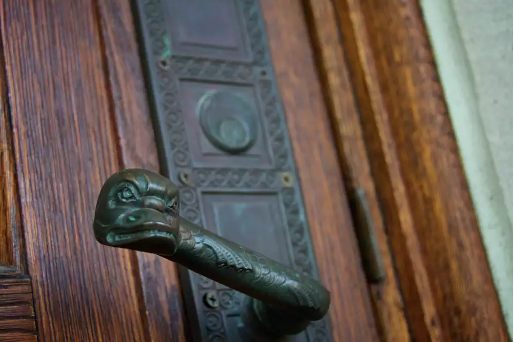
Photo by: jaydrydenphoto.com
Kircher’s Enigma in Keck Hall
At the top of Keck Hall (old chemistry building), displays an engraving known as "Kircher’s Enigma," referencing Athanasius Kircher, a 17th-century scholar renowned for his work in fields like cryptography, alchemy, and Egyptology. Originally, it was by alchemists to confuse observers and conceal a basic principle of alchemy. This one is an elaborate chemistry joke. The first letter of each word in the outer ring spells “svlphvr” or sulphur. In the middle ring it spells “fixvm” and in the inner ring “est sol”. If you put this all together you get: “sulphur fixum est sol.” It means “Fixed sulphur is synonymous with gold.” …I don’t get it.

Photo by: jaydrydenphoto.com
Biology Bricks on Anderson Biological Laboratories
The Anderson Biological Laboratories' exterior features bricks with fossil-like imprints, including that of a fern leaf. These "biology bricks" serve as a tribute to the evolutionary history studied within the building.
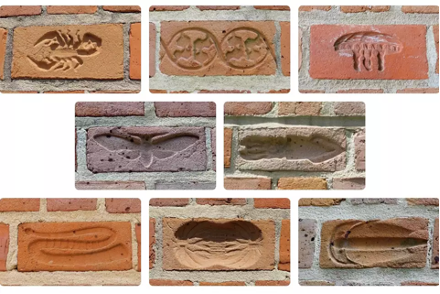
Photo by: jaydrydenphoto.com
Frog Wall at Anderson Hall
Anderson Hall, home to Rice University's School of Architecture, features a unique architectural detail known as the "Frog Wall." Located near the building's east entrance, this wall is adorned with a series of neatly drilled holes arranged in a decorative frieze. When visitors run their fingers across these holes, the wall emits a sound reminiscent of croaking frogs. The origin of the Frog Wall is intertwined with the history of the site. Prior to Anderson Hall's construction in 1947, the area was known to become marshy after Houston's frequent rains, creating a natural habitat for frogs. The wall's design is believed to pay homage to these amphibious former residents, preserving their memory through this interactive architectural feature.

Terra Cotta Reliefs at Will Rice College
Will Rice College is adorned with terra cotta reliefs designed by William McVey. The first one is a joke that represents the life of a student. In it, we observe a broke and half-naked student wearing a barrel, who sends a letter home asking for money.
The second one actually depicts the time when Rice was a football powerhouse (believe it or not). For example, the award given to the best player of the year in college football, the Heisman Trophy, was named after John William Heisman, who coached at Rice from 1924 to 1927.

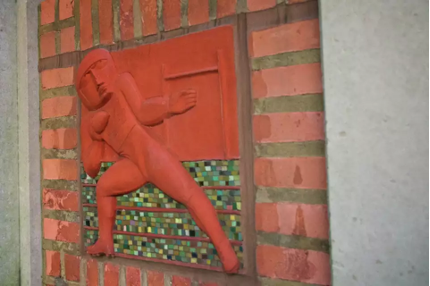
Secret Bible Verses in Baker College
At Rice University's Baker College, a subtle yet profound tribute to wisdom is etched into the architecture. The capitals of the columns at Baker College are adorned with inscriptions from the Book of Wisdom, attributed to King Solomon. These verses read: "I prayed and understanding was given me. I called upon God and the spirit of wisdom came into me. For wisdom is a breath of the power of God. She is the reflection of the everlasting light." This integration of biblical text serves as a quiet reminder of the university's dedication to the pursuit of knowledge and enlightenment, seamlessly blending spiritual reflection with academic endeavor.
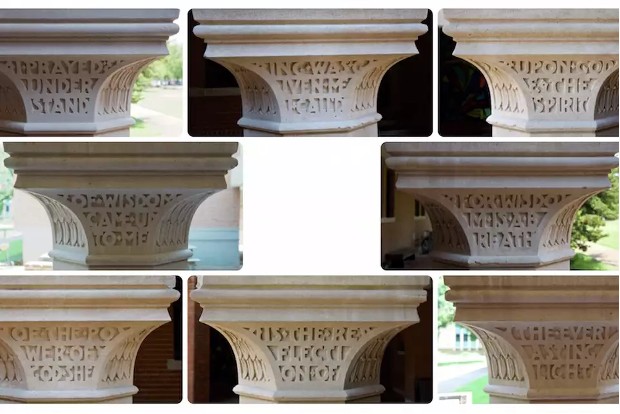
Development of Writing Plaque at Fondren Library
Fondren Library, the main library at Rice University, is adorned with artistic elements that celebrate the evolution of written communication. Designed by architects Staub & Rather in collaboration with William Ward Watkin, the library's facade features relief plaques sculpted by Texas artist Herring Coe. These plaques depict the development of writing, tracing its progression from ancient pictographs to modern alphabets.
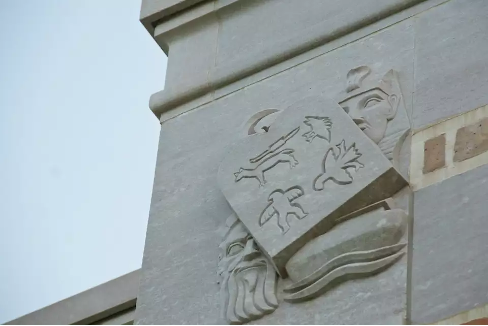
Photo by: jaydrydenphoto.com
Owl Carvings ("Pine-Owl-Ples")
The owl is Rice University’s mascot and Athena’s symbol of wisdom and knowledge. The architects decorated the campus with them at every opportunity. Their name “pine-owl-ples” was coined by Francisca Ortega Houston Chronicle's deputy digital editor.
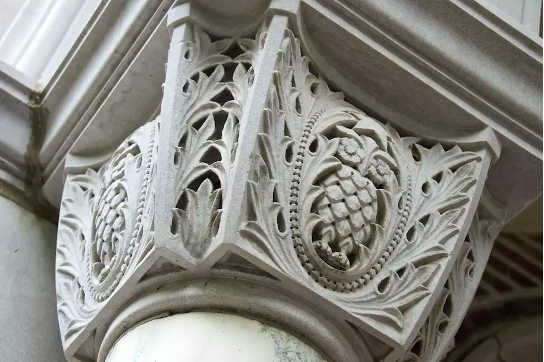
Photo by: jaydrydenphoto.com
From hidden Bible verses to whispering walls, from grumpy dolphin door handles to ancient writing tributes, each stop on this scavenger hunt reveals a piece of Rice University’s rich history and playful spirit. These symbols aren’t just decorations, they’re glimpses into the university’s past, its traditions, and the creativity embedded in its very architecture. Next time you walk across campus, take a moment to look around because at Rice, every detail has a story waiting to be uncovered! I hope you had some fun with this scavenger hunt and get to learn some fun facts and history that’s hidden on campus.
About the author:
Manuel Carmona Pichardo is from Pachuca Hidalgo, Mexico and is a current Ph.D. student in Chemistry. He got his B.S. in Chemistry at Universidad Autónoma del Estado de Hidalgo in 2016 and his MSc in Chemistry from Cologne University in Cologne Germany. Read more.
Further Reading:
Exploring Home and Identity Through Do Ho Suh’s Art at the Moody
Beyond Fondren: Exploring Hidden Book Corners at Rice
The Buckyball—A fortuitous discovery or a clever realization?

